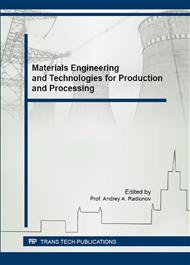p.145
p.151
p.155
p.161
p.167
p.173
p.178
p.183
p.189
The Study of Conditions for the Silicon Carbide Crystals Formation in the Complex Composition Metal Melt
Abstract:
The results of thermodynamic modeling and experimental studies are presented in this article. The aim of this work is to determine the conditions of silicon carbide crystals synthesis in the complex composition metal melts. The "FactSage" software was used for thermodynamic modeling. The phase diagrams, in the form of liquidus surfaces, allow determining the metal composition with minimum melting temperature and presenting the ranges of concentrations and temperatures for which the equilibrium product of the interaction between the components of the metal melt is silicon carbide. The results of experimental research confirmed the possibility of growing silicon carbide crystals in the complex metal melts at low temperatures. The results of the obtained sample of complex alloy examination (conducted with the scanning electron microscope JEOL JSM–6460LV with a energy dispersion spectrometer by "Oxford Instruments" used for performing qualitative and quantitative microprobe analysis) helped to reveal the crystals corresponding to SiC composition.
Info:
Periodical:
Pages:
167-172
Citation:
Online since:
February 2016
Authors:
Price:
Сopyright:
© 2016 Trans Tech Publications Ltd. All Rights Reserved
Share:
Citation:


